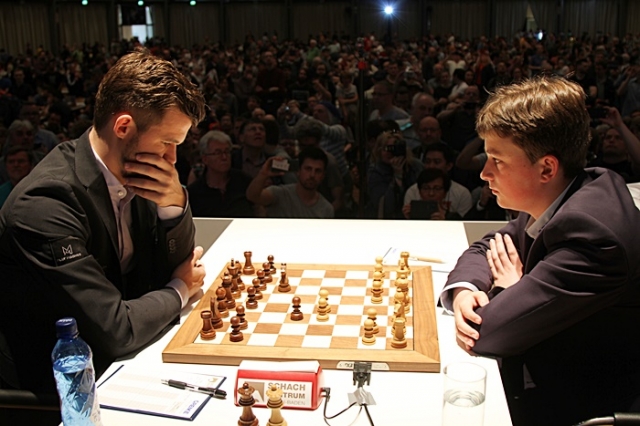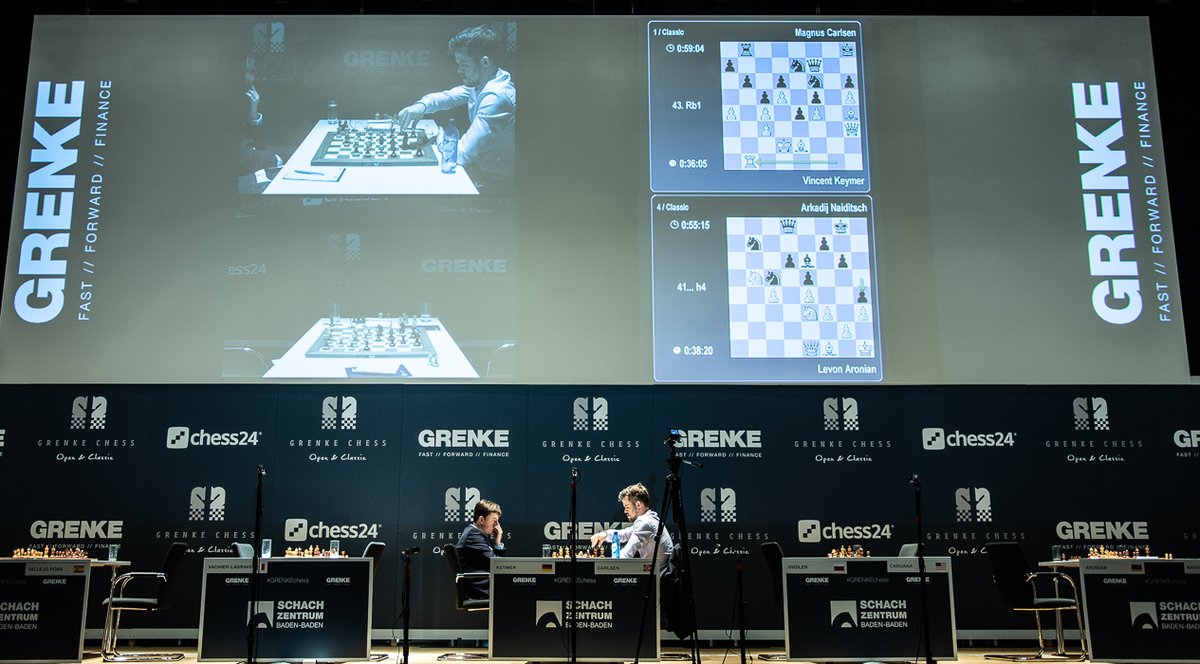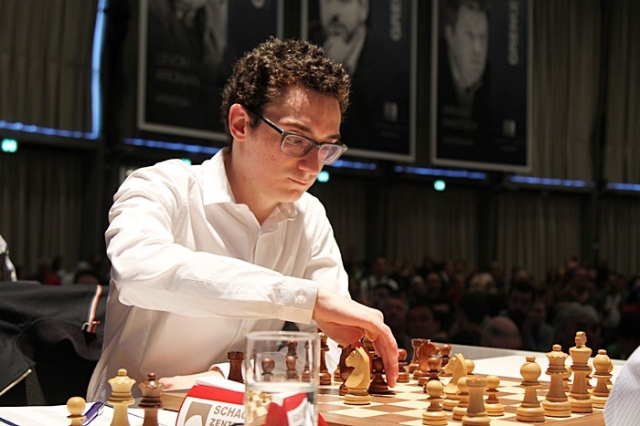


ChessBase 17 - Mega package - Edition 2024
It is the program of choice for anyone who loves the game and wants to know more about it. Start your personal success story with ChessBase and enjoy the game even more.
Picture this: you are 13 years old, looking for ways to increase your rating and gain some experience; you register to play in an Open with over seven-hundred players and find yourself as the 99th seed; you win the event against all odds and qualify to play in next year's super-tournament; when the big event is about to begin, the drawing of lots pairs you up against the world champion right after he had one of the best performances of his career...
Now picture this: you have just dominated a category 22 tournament with a 2991 rating performance; the whole world expects you to keep that up; you are paired against a player with a rating over 300 points below yours in the first round of your next event; you have the black pieces...
First round @GRENKEChess Classics is about to start. With @advorkovich for the first move. Full house in the playing hall. Good for chess!! pic.twitter.com/6Cw937t4PH
— Jeroen Van Den Berg (@Jvdbergchess) 20 de abril de 2019
The stage looked set for a memorable game, and the protagonists went on to give a big show. Carlsen, pressured to win, played the Benoni and quickly expanded on the kingside. A closed position seemed to be exactly what the world champion needed in order to outplay his young opponent. But the computer evaluation, as it tends to happen in these positions, favoured White. By move 20, Keymer is in the driver's seat:
Modern Benoni for Advanced Players
The Modern Benoni is perhaps the most dynamic approach to meeting 1.d4 without sacrificing a pawn. A lot of legendary players have had a sincere love affair with this opening. The most imaginative world champion of all time, Michail Tal is perhaps the player who has done most to popularise the opening. In this DVD International Master Ari Ziegler is giving you a fighting repertoire against all White systems in the Modern Benoni.
The computers call for a quick 21.g4, as Black's king position seems more vulnerable than White's. Nonetheless, we cannot blame Vincent for playing 21.♖g1, building up his position before opening up the kingside.
Ten moves later, Keymer had already pushed his g-pawn up to the fifth rank, but, unlike what we saw on the previous diagram, postponing the advance was best.
It is amazingly hard to assess the position on the board. White has the initiative on the kingside and could easily mount up the pressure with moves like 30.h4, 30.♕g2 or 30.♕g3, but now decides to continue moving forward with 30.g6. The computer gives 30...♞f6 or 30...♞e8 as the best options for Black, but Carlsen chooses 30...h6. Keymer's clock is ticking down with ten moves to go before the time control...

Vincent got a good position out of the opening | Photo: Georgios Souleidis
The young German wastes a couple of tempi during zeitnot and lets go of the initiative. Carlsen takes advantage of the situation and gains a pawn. The position after move 40:
The first DVD deals with the initial phase of the game, when the all the reigning principles can be crystalized into just one: DEVELOPMENT!
Magnus starts showing his class, rearranging his pieces and patiently looking for the best way to break through, until, out of the blue, he incorrectly invites Keymer to exchange the rooks:
Here Black could have started advancing his passer on the a-file or improve his rook with 56...♜b7, but instead chose 56...♜g7, offering an exchange of rooks that clearly alleviates White's position.

Alone on the big stage | Photo: Official Twitter account
The queens were exchanged on move 64, with White having a pair of bishops against Black's pair of knights. Not long afterwards, however, Keymer erred in the technical phase of the game:
On this 60 Minutes renowned and successful coach Adrian Mikhalchishin presents critical positions and shows how to handle them.
Try your own variations on the diagram above!
White could have pushed for a favourable exchange of pieces with 67.♔b3 ♞e2 68.♗xf6+ (getting rid of the knight) ♚xf6 69.♗xe4 ♞xf4 and a draw would be the most likely result. Instead, Keymer played 67.♗f2 and Black gobbled up a pawn with 67...♞e2 68.♔a4 ♘xh5 — White cannot capture on e4 due to the knight fork from c3.
Magnus did not look back from this point on and Keymer's resignation came on move 81. It was nothing short of a baptism of fire for Peter Leko's pupil.
Carlsen was interviewed quickly afterwards. He mentioned that both his play and Keymer's "could have been vastly improved many, many times". He added: "To be honest, it's not really a memorable game for me in terms of quality; in terms of a fight, for sure..."
In what became the thematic opening of the duel, Fabiano Caruana faced Carlsen's Sveshnikov Defence several times during last year's World Championship match in London. Since then, as it happens with World Championship theoretical discussions, the first moves played by Magnus and Fabiano were seen over a couple dozen times in tournament games.
In Karlsruhe, Caruana repeated eighteen moves from game eight...but from the black side. Peter Svidler tested the American in a line that Fabiano surely studied in depth — in the post-game interview, Caruana confessed that he did look deeply at this line, but only right after the match, not recently.
Known for his strength in dynamic positions, Svidler kept the balance all throughout, and the draw was signed in an absolutely dry position after 40 moves:
My best games in the Sveshnikov
The Sveshnikov Variation of the Sicilian Defence is considered one of the most promising replies to 1.e4, often giving rise to sharp and complex positions which require precise and inventive play from both sides. Thus, an opening tailor-made for Alexei Shirov (FIDE World Cup finalist in 2007), who has included it into his repertoire with both White and Black and knows the mutual tricks and traps all too well.

Defending champion Fabiano Caruana | Photo: Georgios Souleidis
Maxime Vachier-Lagrave and Vishy Anand found a threefold repetition after 20 moves, while Georg Meier and Francisco Vallejo Pons needed five more moves to reach a peaceful end in their game. Levon Aronian and Arkadij Naiditsch surpassed the time control, but their encounter never left the realms of equality.
GM Daniel King brings you the highlights of Round 1
Magnus will have the black pieces once again in round two, this time against Paco Vallejo, while Keymer will need to recover quickly from a heart-breaking loss, as he will face Vishy Anand on Sunday. However, the biggest clash of round two will be Caruana vs Vachier-Lagrave.

A huge chess celebration in Karlsruhe | Photo: Georgios Souleidis